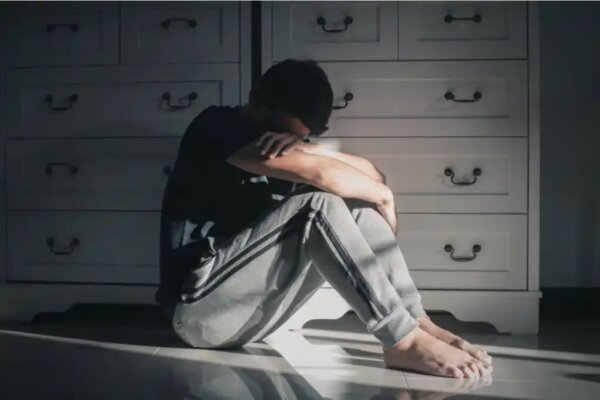Cave Syndrome: Fear of the Outside World


Written and verified by the psychologist Valeria Sabater
Some people consider cave syndrome a condition of our time. It describes those people who prefer the intimacy of their home to the outside world. Furthermore, they feel unable to return to their routines, social interactions, and face-to-face work. However, this avoidance behavior has always been around, particularly in people with anxiety disorders.
After a year of lockdown, some people are choosing to remain in their own homes until the pandemic is over once and for all. However, psychology professionals from all over the world are noticing that others are completely refusing to entertain the thought of any kind of life beyond the limits of their own home.
This syndrome isn’t new. In fact, even though the Diagnostic and Statistical Manual of Mental Disorders (DSM-5) doesn’t recognize it as a clinical condition, it represents an all too frequent reality. The difficulty of resuming life after an adverse event is something that’s always defined human nature.
Cave syndrome is synonymous with suffering. Sufferers know they must resume their life. However, the mere thought of crossing the threshold into the outside world makes them anxious.

The characteristics of cave syndrome
Long before the current situation, experts recognized the Hikikomori syndrome. This Japanese term describes the tendency towards isolation on the part of many young people who choose to abandon their social life and stay in their homes. It affects more men than women. A type of social phobia is usually behind it. This might be in the form of agoraphobia, shyness, or even avoidant personality disorder.
Cave syndrome shares many of these characteristics. However, it has one peculiarity. It appears after a complex or traumatic event that makes the sufferer decide that the safest place for them to be is in their home.
Due to the current situation, this syndrome is now more widely recognized. However, sufferers had usually experienced prior sexual or workplace harassment and bullying.
Definition
Cave syndrome is when a person feels safer in their home and has a hard time taking charge of their social life.
Unlike people with Hikikomori syndrome, cave syndrome sufferers wish they could leave home and return to work and spend time with family and friends outside their home. However, they feel incapable of doing so.
Symptoms
The main defining characteristics of cave syndrome are suffering and distress. Sufferers are aware that they must venture outside their homes and take responsibility for their life. However, they feel unable to do so. They might experience the following symptoms:
- They feel extremely anxious when they have to do something outside their home. For example, going to the doctor or other important appointments or visiting relatives. In fact, they’ll often feel distressed and worried in the days before.
- Cave syndrome affects introverts and extroverts. Some suggest that the phenomenon is similar to Stockholm syndrome. This occurs when a captive or hostage develops an inordinate closeness to their captor (in this case, their home).
- They develop anxiety about leaving their home after having a bad experience. Nowadays, the trigger is the current situation. However, it can also occur in people who’ve been on leave after depression or due to sexual or workplace harassment. In these cases, the home becomes their safe place. Although they know they have to leave at some point, the thought makes them feel uncomfortable.
This chronic avoidance of activities beyond their safe environment also causes physiological symptoms such as dizziness, numbness, and tachycardia.

The causes of cave syndrome
Cave syndrome is directly linked to social anxiety disorder. In fact, many sufferers have suffered this condition. These disorders have greatly increased in recent years, especially among the younger population.
Experts from Dalhousie University in Canada conducted an interesting study. They found that social anxiety disorders affect or have affected approximately 36 percent of 16- to 29-year-olds.
Avoiding social situations and staying home is now extremely common. It’s become even easier with the advent of new technologies for both work and leisure purposes. The pandemic has served to aggravate this pre-existing reality. For this reason, we should try to refocus our attention. This way, we might be able to prevent and address these types of difficult situations.
All cited sources were thoroughly reviewed by our team to ensure their quality, reliability, currency, and validity. The bibliography of this article was considered reliable and of academic or scientific accuracy.
- Buckner, J. D., Abarno, C. N., Lewis, E. M., Zvolensky, M. J., & Garey, L. (2021). Increases in distress during stay-at-home mandates During the COVID-19 pandemic: A longitudinal study. Psychiatry research, 298, 113821. https://doi.org/10.1016/j.psychres.2021.113821
- Hofmann S. G. (2010). Special section: advances in the research of social anxiety and its disorder. Anxiety, stress, and coping, 23(3), 239–242. https://doi.org/10.1080/10615801003612014
- Zheng, L., Miao, M., Lim, J., Li, M., Nie, S., & Zhang, X. (2020). Is Lockdown Bad for Social Anxiety in COVID-19 Regions?: A National Study in The SOR Perspective. International journal of environmental research and public health, 17(12), 4561. https://doi.org/10.3390/ijerph17124561
This text is provided for informational purposes only and does not replace consultation with a professional. If in doubt, consult your specialist.








